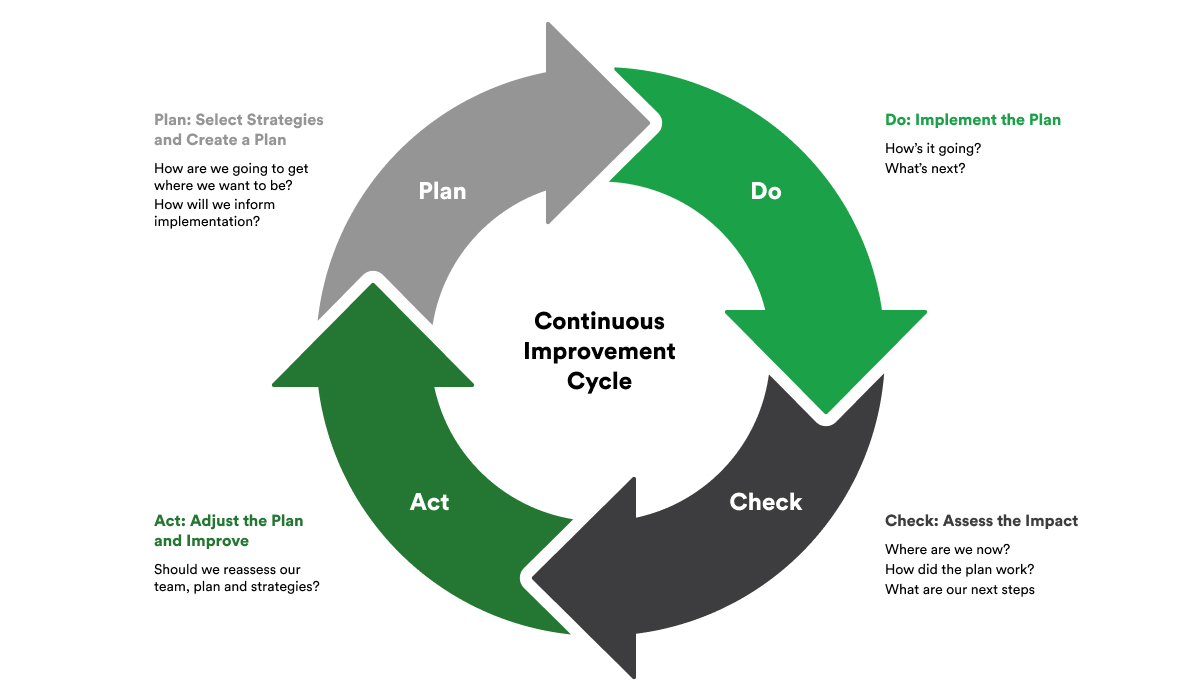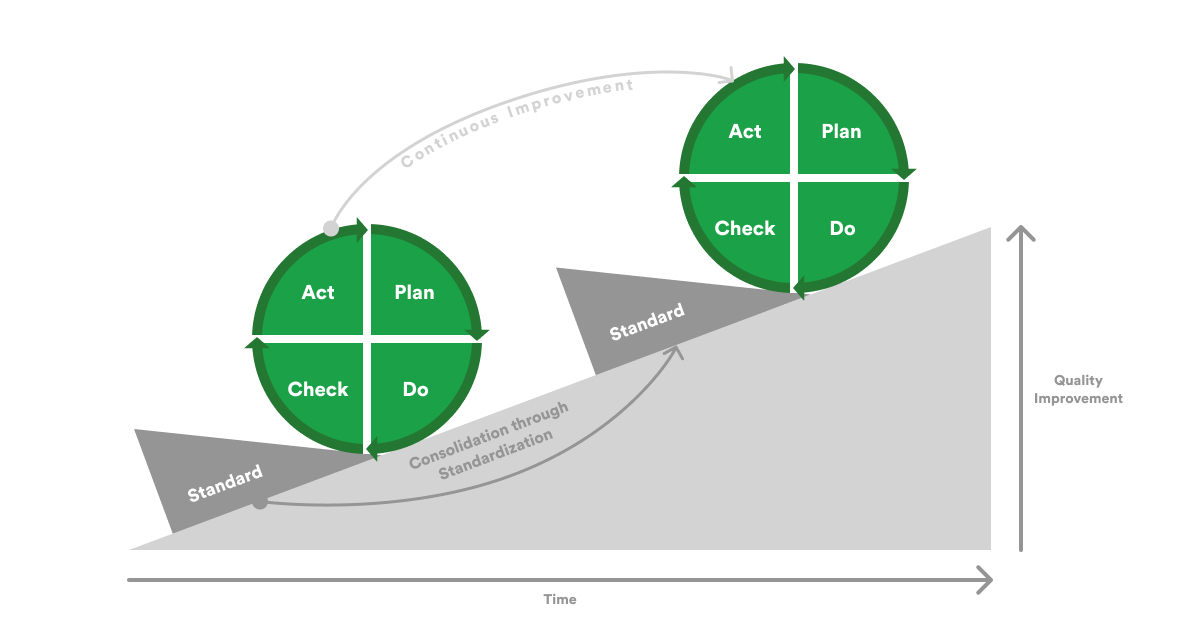
How to Roll Out an Innovation Project Within Your Company: Tips and Best Practices
This article will share three strategies to help R&D teams effectively and successfully implement new technologies.
Research and industry trends prove companies committed to continuous improvement outperform their competitors. These organizations not only report higher performance metrics but also display an enhanced capacity to navigate the complexities of the tech sector. It is a culture that thrives on feedback, learning, and adaptability, encouraging teams to view challenges as opportunities for growth and development.
This article focuses on actionable strategies for cultivating such a culture, offering tech teams the insights to embark on this transformative journey. Through a commitment to continuous learning, transparent communication, and employee empowerment, tech companies can unlock their full potential, ensuring long-term success in an industry that waits for no one.
The foundation of a culture of continuous improvement in tech companies is built upon several critical pillars, each contributing to the overall resilience and adaptiveness of the organization.
The foundation of a thriving culture of continuous improvement within any tech organization is anchored in leadership commitment. This commitment goes beyond verbal endorsements. The company’s leaders need visible, active participation in ongoing improvement initiatives. When leaders lead by example, it sends a powerful message throughout the organization about the value of continuous improvement. This involves participating in initiatives and dedicating resources towards the development and implementation of them. It means allocating budget, time, and tools for teams to pursue improvement projects.
Furthermore, leadership commitment is reflected in how successes are celebrated, and failures are addressed. A leader committed to continuous improvement culture recognizes the importance of learning from setbacks, viewing them not as obstacles but as steppingstones toward innovation and efficiency. They celebrate small wins and significant breakthroughs, fostering an environment where every effort toward improvement is acknowledged and appreciated.
In the quest to build a robust culture of continuous improvement within tech organizations, the role of communication and transparency cannot be overstated. Effective communication is the heart of ongoing improvement efforts, ensuring that these initiatives’ goals, processes, and outcomes are clearly understood across the organization. Through transparent and open communication, a shared vision for continuous improvement is fostered, uniting teams towards common objectives. Leaders play a pivotal role in establishing this environment by consistently communicating the importance of constant improvement and the specific goals the organization aims to achieve.
Moreover, transparency in sharing both successes and challenges are fundamental. Organizations cultivate a culture of trust and learning by openly discussing the outcomes of continuous improvement efforts, including those that did not deliver the expected results. This openness encourages employees to share their ideas and feedback without fear of reprisal, knowing that their contributions are valued and that challenges are viewed as opportunities for growth.
Empowering employees is vital in establishing a culture of continuous improvement within tech organizations. This empowerment exceeds the traditional delegation of tasks, evolving into a comprehensive approach that recognizes and nurtures each employee’s unique insights, skills, and potential. At the heart of this approach is creating an environment where employees feel genuinely valued and confident in contributing to the organization’s continuous improvement efforts.
First, it involves providing them with the tools, resources, and training necessary to perform their roles effectively and think critically about improving processes and products.
Second, empowering employees means actively requesting their input and feedback. This can be achieved through structured programs like suggestion boxes, innovation challenges, regular brainstorming sessions, and informal channels. It’s about creating a culture where employees feel they have a voice, and their ideas are heard and valued.
Lastly, empowerment is closely tied to trust. By trusting employees to take initiative and make decisions within their areas of expertise, organizations reinforce their commitment to continuous improvement.
rinf.tech’s ART program (Agile Root Team) is an excellent example of driving organizational change, enhancing project delivery, and building a robust culture of innovation and continuous improvement. By leveraging agile principles and empowering cross-functional teams, the ART program helps us remain at the forefront of technological advancement and customer satisfaction.

Continuous Improvement (CI) Cycle
Implementing a culture of continuous improvement within a tech organization requires more than just a strategic vision. It demands a deliberate and thoughtful approach that pervades every level of the company.
Implementing a culture of continuous improvement is enhanced by emphasizing small, incremental changes. This strategy is key because it allows organizations to cultivate a sense of achievement and momentum among teams, which is essential for sustaining long-term engagement with continuous improvement efforts. Starting with manageable adjustments or enhancements enables teams to experiment and repeat quickly, minimizing risk and fostering a learning environment where feedback is rapidly incorporated into future iterations. T
This approach makes the improvement process more digestible and less daunting for employees and shows the cumulative impact of small changes over time. Organizations reinforce the value of ongoing, gradual progress by recognizing and celebrating each step forward, no matter how minor it may seem. This, in turn, builds confidence among employees in their ability to contribute to meaningful change, creating a virtuous cycle of improvement and innovation.
The commitment to data-driven decision-making is at the core of a thriving continuous improvement culture. This principle highlights the importance of grounding decisions in factual, objective data rather than intuition or assumption. By leveraging metrics and analytics, organizations can pinpoint improvement areas, track the effectiveness of implemented changes, and guide strategic decisions about future initiatives. Using data empowers teams to take a structured approach to improvement, focusing efforts where they are most needed and where the potential for impact is most significant.
Furthermore, data transparency is crucial in this process, enabling a shared understanding of the organization’s goals, progress, and outcomes. This transparency helps align team efforts and fosters a culture of accountability and continuous learning. Employing data-driven methodologies requires the right tools and training for employees, ensuring they can analyze and interpret data effectively. Ultimately, this commitment to data-driven decision-making enriches the continuous improvement culture, making improvements more strategic, informed, and effective.
A vital component of embedding a continuous improvement culture is the balanced approach to celebrating successes and learning from failures. Recognizing and rewarding the efforts and achievements of teams and individuals is a powerful motivator, reinforcing the behaviors and actions that lead to positive outcomes. Celebrations for small milestones or significant breakthroughs boost confidence and encourage further participation in improvement activities. Equally important is the organization’s approach to failures. Instead of fostering a blame culture, tech companies should treat failures as valuable learning opportunities.
Openly discussing what went wrong, analyzing the root causes, and stemming lessons learned cultivate a resilient and adaptable workforce. This approach not only demystifies failure but also encourages a mindset of experimentation and innovation, where risks are taken, and failures are seen as steppingstones to success. By balancing celebrating successes with constructive responses to failures, organizations strengthen their continuous improvement culture, making it more dynamic, inclusive, and sustainable.
The maintenance and growth of a continuous improvement culture are intrinsically linked to constant learning and development opportunities for employees. By investing in their workforce’s ongoing education and skill enhancement, organizations underscore the importance of adaptability and proficiency in the face of evolving industry demands. This commitment to learning enables employees to stay up to date on the latest technologies, methodologies, and best practices, ensuring the organization remains competitive and innovative. Training programs, workshops, and seminars focused on continuous improvement methodologies, such as Lean, Six Sigma, or Agile practices, empower employees with the tools and knowledge to identify inefficiencies, propose improvements, and implement solutions effectively.
Additionally, fostering a culture that encourages curiosity, exploration, and cross-functional collaboration enhances the collective problem-solving capabilities of the organization. Providing platforms for knowledge sharing and mentorship further enriches this learning ecosystem. Through continuous learning and development, companies improve their operational efficiencies and innovation capacities and display a commitment to their employees’ growth and satisfaction, attracting and retaining top talent in the competitive tech industry landscape.

The Concept of Continuous Improvement (CI)
To gauge the effectiveness of implementing a culture of continuous improvement (CI) within tech teams, it’s essential to establish clear, quantifiable metrics. These metrics not only demonstrate the tangible benefits of CI initiatives but also help in fine-tuning strategies to further enhance performance and innovation. This section outlines key indicators and methods for measuring the success of a CI culture in tech environments, ensuring organizations can track progress, celebrate achievements, and identify areas for further improvement.
Innovation Rate: Measure the number of new ideas or projects implemented within a certain period. This reflects the vibrancy of the CI culture in generating and executing innovative solutions.
Cycle Time Reduction: Track the time it takes to complete projects or deliver products before and after CI initiatives. Reductions indicate efficiency improvements and faster time-to-market, a critical advantage in the tech industry.
Employee Engagement and Satisfaction: Use surveys and feedback tools to assess employee involvement in CI processes and their overall job satisfaction. High engagement levels signify a healthy CI culture that values and utilizes employee contributions.
Customer Satisfaction and Feedback: Analyze customer satisfaction scores and feedback pre and post-implementation of CI changes. Improvement in these areas suggests that CI efforts are effectively enhancing product quality and customer service.
Process Efficiency Improvements: Quantify the efficiency gains in various processes, such as reduced waste, lower defect rates, or improved utilization of resources. These improvements directly contribute to cost savings and higher quality outputs.
Learning and Development Opportunities: Track the number and quality of training sessions, workshops, or learning modules offered and completed. This metric underscores the organization’s commitment to continuous learning as a pillar of CI.
Financial Performance: Monitor financial metrics like revenue growth, profit margins, and cost savings attributable to CI initiatives. Though indirect, these indicators reflect the overarching impact of a CI culture on the organization’s financial health.
Surveys and Questionnaires: Regularly distribute surveys to employees and customers to gather feedback on the CI culture’s effectiveness and areas for improvement.
Data Analytics: Leverage data analytics tools to measure performance metrics, process efficiencies, and other quantitative indicators of CI success.
Performance Review Meetings: Conduct regular review meetings to discuss KPIs, celebrate successes, and strategize on addressing any areas falling short of goals.
Continuous Feedback Mechanisms: Implement real-time feedback tools to capture ongoing insights from employees and customers, enabling quick adjustments and fostering a responsive CI culture.
Innovation Audits: Periodically review the innovation pipeline and project outcomes to assess the quality and impact of new ideas and solutions generated.
Evaluating the success of a CI culture is itself an iterative process. It’s crucial for organizations to regularly review and adjust their measurement strategies to ensure they remain relevant, comprehensive, and aligned with evolving business objectives and industry dynamics. This adaptability not only enhances the accuracy of success metrics but also reinforces the principles of continuous improvement at the heart of the organization’s culture.
By diligently tracking these indicators and employing a dynamic approach to measurement, tech companies can solidify their CI culture, driving sustained innovation, efficiency, and competitiveness in the fast-paced tech landscape.
The journey toward embedding a culture of continuous improvement within tech organizations is both a strategic imperative and a transformative effort. By embracing small, incremental improvements, making data-driven decisions, celebrating successes, and learning from failures, organizations can navigate the complexities of the tech industry with agility and resilience.
As we move forward, we strongly encourage tech teams and leaders to integrate these principles into the core of their organizational culture. The journey of continuous improvement offers an opportunity to achieve operational excellence and build a resilient, innovative, and forward-thinking organization. It is a pathway to competitive advantage in a rapidly evolving industry landscape.

This article will share three strategies to help R&D teams effectively and successfully implement new technologies.

A Comprehensive Guide to Building a Career as an Automotive Software Engineer

This article offers some actionable tips for anyone looking to advance their knowledge of embedded software programming or switch jobs in 2023.
Copyright © 2023 rinf.tech. All Rights Reserved.
Terms & Conditions. Cookie Policy. Privacy Policy.
Politica Avertizari de Integritate (RO)